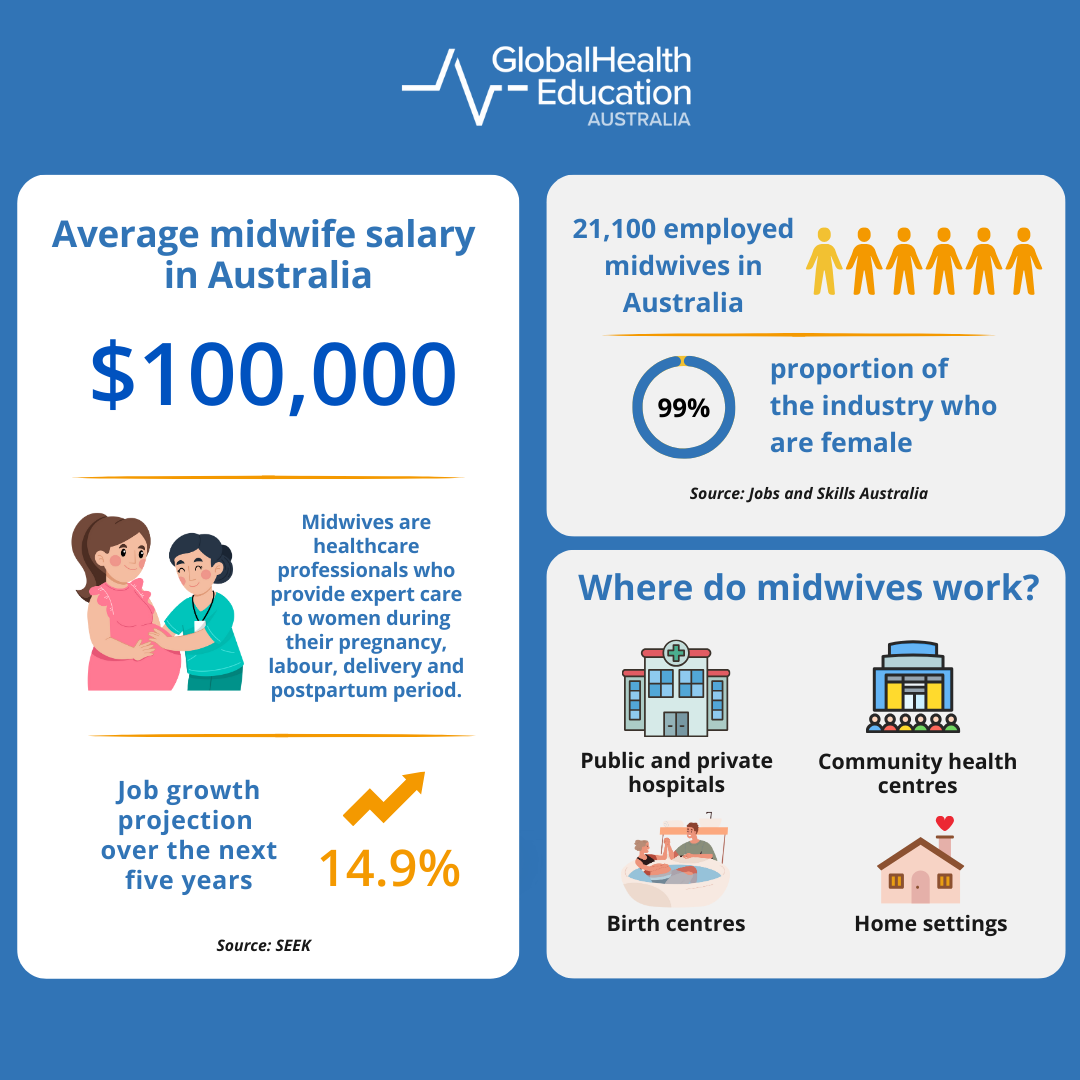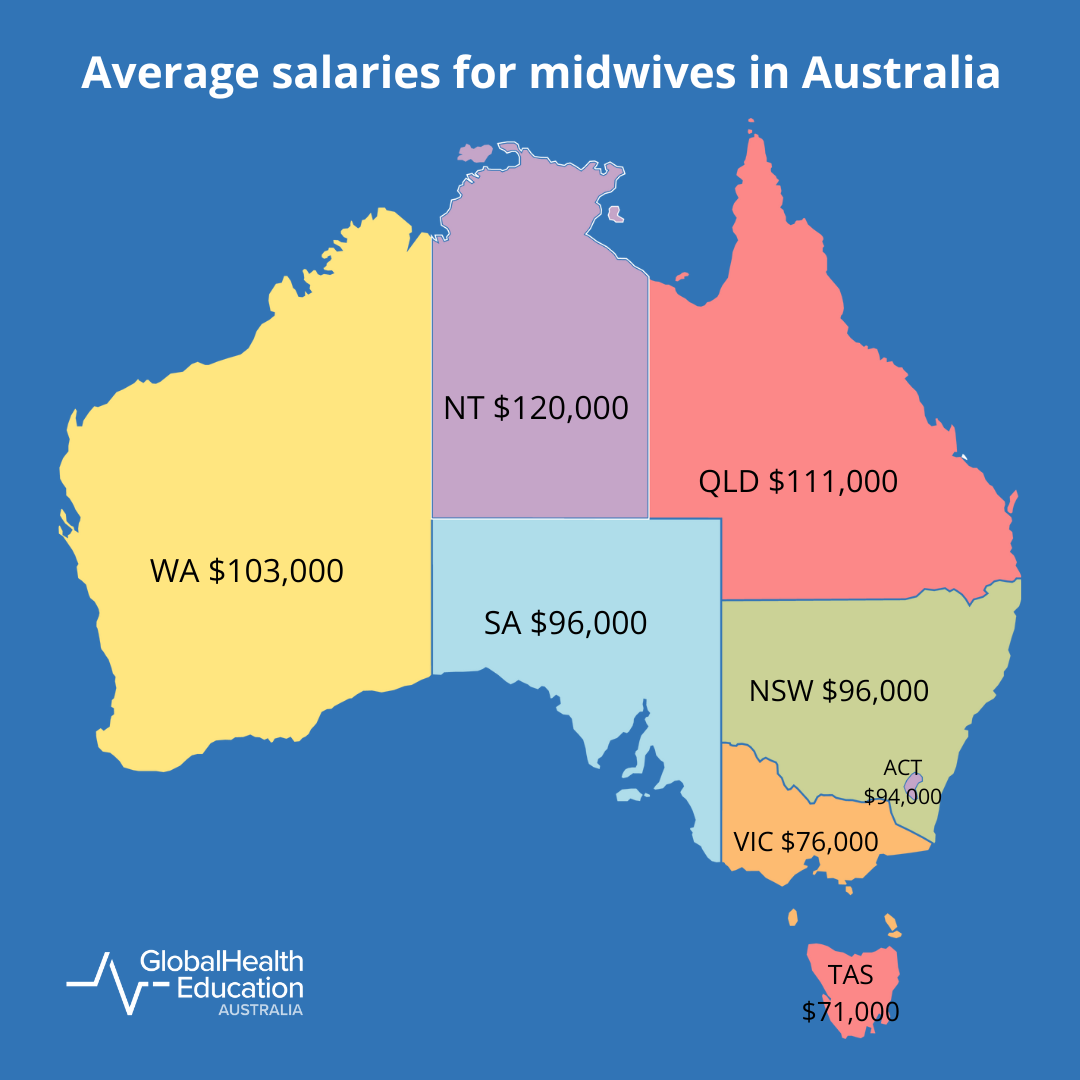In This Article
- Steps to becoming a midwife in Australia
- What is a midwife?
- What is the role of a midwife?
- Where do midwives work?
- How much does a midwife earn?
- Rewards and challenges of being a midwife
- Soft skills and traits of a successful midwife
- Frequently asked questions
- Start a rewarding career in midwifery today
Midwives provide essential care, education and support to expectant parents. They play a vital role in ensuring safe pregnancies and deliveries.
Registered midwives are in high demand across Australia, with an increased annual employment growth of 700 new professionals and strong job growth over the next five years.
This article explores how to become a midwife in Australia, including the typical educational pathways, registration process and what the role of a midwife entails. It also covers the average midwife salaries around Australia, the various rewards and challenges, essential skills for success and postgraduate study options to enhance your expertise in a midwifery specialisation.
Discover how being a midwife allows you to pursue a fulfilling healthcare career supporting parents, their babies and families during the prenatal, pregnancy and postpartum period.
Steps to becoming a midwife in Australia
If you’re considering becoming a midwife, you’ll first need to consider if this is the right career path to pursue. Next, you’ll need to complete either a Bachelor of Midwifery, a Bachelor of Nursing with a postgraduate midwifery qualification or complete a Master of Midwifery if you have a bachelor’s degree in another field. Then, you’ll need to obtain registration as a midwife before applying for jobs in this field.
Below is a breakdown of each step required to become a midwife in Australia.
-
Think about whether this career is right for you
First, it’s important to consider whether this role is suitable for you.If you’re compassionate, a good communicator, empathetic and someone who enjoys a dynamic environment and working in women’s health, then midwifery could be a rewarding healthcare career path to consider.
You should also take into account the study path available to you and how long it takes to become a qualified midwife. It may take from two to five years to complete your studies and enter the midwifery field, depending on your prior education level and experience.Furthermore, it’s worthwhile considering your potential career progression following your initial entry into midwifery. Think about whether you’d like to pursue a specialised midwifery postgraduate course in the field, which could be in areas such as leadership, education or research. Take the time to contemplate your broader career goals as this can help you make the choice that aligns with your aspirations.
-
Complete your midwifery qualification and obtain registration
The most common pathway is to complete a Bachelor of Midwifery, which typically involves three years of full-time study.
Once you’ve decided this is the right career path for you, you’ll need to complete a course accredited by the Australian Nursing and Midwifery Accreditation Council. There are several options available to you to become qualified, depending on your previous experience and prior education.Alternatively, if you already have a nursing degree and are registered as a nurse, you can undertake a Graduate Diploma of Midwifery or Master of Midwifery as pathways to becoming a midwife. These courses can range in duration from between 12 and 18 months full-time for most graduate diplomas and 12 to 24 months full-time for most midwifery master’s degrees. Overall, a nursing degree followed by a midwifery postgraduate course may take between four and five years to complete.
Curtin University’s Master of Midwifery is a unique midwifery postgraduate degree. This course is available to professionals from any field who have not completed a nursing degree and takes two years to complete full-time.
After completing your midwifery education, you must register with the Nursing and Midwifery Board of Australia (NMBA) under the Australian Health Practitioner Regulation Agency (Ahpra) to become a certified practising midwife. There are also annual renewal and professional development requirements you need to maintain while you’re practising as a midwife.
-
Explore and apply for midwifery jobs
After you obtain your registration, you can look for career opportunities within the profession of midwifery. This will give you valuable experience in various roles to enhance your skills and develop your career.Connect with your professional peer network to find out about local or new job opportunities. You can also search for midwifery roles on job boards such as SEEK, Indeed and LinkedIn. There may also be opportunities through nursing agencies and directly via government health department job listings.
You can also explore industry-specific organisations, such as the Australian College of Midwives, to find out about job openings as well as for support, resources and information relevant to midwives in Australia.
-
Optionally upskill with a specialisation in midwifery
Once you have gained experience in the field, you may wish to enhance your skills in a niche area that interests you.Many postgraduate midwifery courses require the completion of a minimum of six months of clinical experience in the field as an entry requirement. You might consider an entry-level postgraduate course, such as a Graduate Certificate in Midwifery. These courses typically take between 6 and 12 months to complete full-time.
There are a variety of ways you can take your midwifery career to the next level with a graduate certificate program. For example, the University of South Australia offers a Graduate Certificate in Midwifery and a Graduate Certificate in Midwifery (SA Health Clinical Specialisation Program). These courses are delivered online and deliver extended knowledge in midwifery practice while providing a pathway to further study with a Master of Midwifery.
The University of Tasmania offers various midwifery specialisations through its range of graduate certificates, such as the Graduate Certificate in Midwifery (Quality and Safety), Graduate Certificate in Midwifery (Leadership in Practice), Graduate Certificate in Midwifery (Clinical Teaching), Graduate Certificate in Midwifery (Neonatal Care) and Graduate Certificate in Midwifery (Child and Family Health). Each course gives you a tailored learning experience to help you specialise in an area of midwifery practice that aligns with your interests and career goals.
Edith Cowan University offers a Graduate Certificate in Midwifery Diagnostics and Prescribing which is a specialised midwifery course designed to enhance your knowledge of safe and effective prescribing for childbearing women and comprehension of investigative tests to support the health and wellbeing of both mother and baby.
A similar course is available through Curtin University, which is offered both online and face-to-face. These two courses give graduates the expanded scope of practice for prescribing and opportunities for career advancement into further clinical, leadership or research roles.
What is a midwife?

A midwife is a qualified healthcare professional who provides expert care to expectant parents during their pregnancies, during labour and delivery and during the postpartum period. They have advanced skills and knowledge of how to support parents and babies during this crucial time. They can also work with obstetricians, neonatal nurses and other specialists or allied health professionals.
Midwives work closely with women to offer expert care, education and guidance throughout their experience of pregnancy, birth of their baby and for the early weeks of motherhood, which usually lasts until six weeks postpartum. Midwifery is a specialised field in healthcare that prioritises woman-centred, evidence-based care, supporting the physical, emotional and overall wellbeing of both birth parent and baby.
What is the role of a midwife?
These are the primary roles and responsibilities of a midwife:
- Providing specialised care for expectant parents and newborns throughout the pregnancy, childbirth and postpartum phases (up to six weeks after birth)
- Assisting birthing parents with a wide range of pregnancy-related conditions, from routine pregnancies to high-risk situations
- Supporting pregnant people through prenatal assessments, childbirth and postpartum care
- Offering emotional and physical support to ensure a safe and healthy pregnancy and childbirth experience
- Conducting thorough prenatal assessments and monitoring the health of both birthing parent and baby
- Developing customised care plans to ensure the wellbeing of expectant parents and newborns
- Utilising advanced obstetric and neonatal tools and techniques to monitor pregnancies and ensure safe deliveries
- Advocating for the health and safety of expectant birthing parents and newborns by promoting evidence-based midwifery practices
- Maintaining detailed patient records and documenting assessments, care plans and interactions with other healthcare providers to ensure coordinated and effective care
In Australia, midwives commonly operate within a continuity of care model, which means they are the consistent caregiver that supports the birth parent throughout their journey. In this way, the expectant parent receives expert and tailored care from the same midwife during the months of their pregnancy, while they deliver their baby and in the first six weeks thereafter.
Some midwives will work with expectant parents during their birth experience only, particularly if they’re under the care of an obstetrician in a private hospital setting. Midwives typically work with a woman-centred framework, which means they support normal, physiological pregnancy and birth and will only offer medical intervention when it’s deemed necessary. They are highly trained to monitor, observe and address any health-related concerns and to manage complications to effectively care for the birthing parent and baby.
Here is a breakdown of the specific care midwives provide expectant parents and their babies:
Antenatal period
During the antenatal or prenatal period, a midwife conducts regular check-ups to monitor the health of the birthing parent and baby, offering advice on nutrition, exercise and preparation for birth. They also perform physical and mental health screenings, manage minor concerns and offer emotional support throughout the pregnancy. If necessary, they will refer to other health professionals, such as dietitians, psychologists or specialists to provide comprehensive and personalised care during the gestational period.
Labour and delivery
A midwife supports the expectant parent during this important time. They’ll guide them through contractions, monitor the baby’s and birthing parent’s vital signs and assist in the safe delivery of the baby. They may also provide pain relief options and ensure the birthing environment is calm and supportive. In a hospital setting, they may work with obstetricians, NICU nurses and other staff. In a home setting, they will support the expectant parent similarly and may work alongside a doula who provides extra emotional and wellbeing support. They may refer their patient(s) to a hospital if there are complications that require additional medical care.
Postpartum period
In the postpartum period, a midwife checks the physical and emotional recovery of the birth parent, monitors the baby's health and provides support and resources with feeding and newborn care. They may refer to health professionals, such as women’s health physiotherapists or lactation consultants to provide more specific support with postpartum recovery and breastfeeding. They also offer guidance on and adjusting to life with a new baby.
Where do midwives work?
Most midwives work in hospitals. However, some are based at community health clinics, private practices, birthing centres and home birth settings. These settings are differentiated by their primary focus, as listed below.
Public and private hospitals: Midwives work closely with medical teams, often managing high-risk pregnancies and medical interventions like C-sections.
Community health clinics: Midwives focus on health promotion with a holistic approach and preventive care such as gestational diabetes screening.
Private practices: These practices offer personalised, one-on-one care.
Birthing centres: These centres provide a home-like atmosphere for natural births with medical oversight.
Home birth: This setting prioritises individualised, natural childbirth experiences.
How much does a midwife earn?

The average midwife salary in Australia is $100,000. A midwife’s salary can vary depending on experience and location.
Here are the average annual salaries for midwives across each Australian state and territory:
Rewards and challenges of being a midwife

Rewarding aspects of midwifery
Strong continuity of care: In many clinical midwifery roles, there is a strong continuity of care provided to patients throughout their experience. This means you can provide a high quality of care to both parents and their babies and build a meaningful, trusting relationship that encourages positive outcomes. According to the Australian College of Midwives, the continuity of care model increases the likelihood of expectant parents having normal births, having healthier babies and an overall positive birth experience, which can be professionally fulfilling for midwives.
Professional autonomy: In comparison to many nursing roles, midwives can often work independently, especially in certain settings like home birth or private midwifery. They are commonly responsible for making important clinical decisions and use their expertise in midwifery practice to support the needs of both the delivering parent and baby. This level of professional autonomy could be another rewarding part of the job.
Growing job demand: The midwifery sector in Australia is robust and continues to increase, with an expected job growth of 14.9 per cent over the next five years. This means midwifery is in high demand and affords strong job security into the future. Jobs may extend into both clinical midwifery roles and non-clinical roles, such as research, education and leadership, which adds variety and advancement to your career path.
Challenges involved in midwifery
High emotional toll: Supporting expectant parents during complicated pregnancies and births, such as pregnancy loss, emergency caesarean sections or other unexpected events can all be emotionally taxing for midwives. While the connection built with patients may be rewarding, it also makes the role emotionally demanding, as you develop strong bonds with patients, their babies and families. For longevity and to avoid professional burnout, it’s important for midwives to establish strong boundaries that allow for both compassion and the delivery of quality care.
Physical demands: Unpredictable hours, different work environments and the requirements of assisting parents in their delivery may all contribute to the physical demands of being a midwife. You might receive a phone call in the middle of the night to attend a home-birth or wait several hours in a hospital setting during labour and delivery. The job can be exhausting, which may impact your role or your overall wellbeing if not balanced by taking care of your physical fitness.
Complexity of clinical decision-making: Midwives must make quick decisions that may potentially affect the health of two patients at the same time. In this role, you need to be able to interpret subtle sights of distress and identify when to escalate care if needed. There is a high level of responsibility and the decision-making may be complex, especially when balancing the patient’s wishes for their care and the need to intervene to protect the health of both patients.
Soft skills and traits of a successful midwife

Women’s health advocate
Midwives play a key role in protecting and promoting women's rights, choices and dignity. As Kay Lin shares, “Every single day, you see how strong and resilient women are.” When expectant mothers make informed choices about their health, they become empowered in their decision-making, which directly impacts physical health and emotional wellbeing outcomes for themselves and their baby. An interest in women’s health also helps midwives stay informed and passionate about providing holistic, patient-centred care and advocating for women.
Calm and reassuring
Birth can be unpredictable, emotional and sometimes stressful for expectant parents and their families. Ensuring you bring a calm presence, remain composed and reassure your birthing patient can help reduce fear and set the right tone for a positive birth experience. Patients need to feel safe in your care, feel confident in their ability to participate in their birth and will look to a skilled midwife for guidance.
Excellent communicator
Being an excellent communicator is an essential skill for midwives to cultivate. You’ll need to explain medical procedures and interventions clearly, making sure you present all the risks and benefits so patients can make an empowered choice. You’ll also need to communicate well with other healthcare professionals, ensuring your patients receive the best possible care. Strong communication skills help to build trust, reduce errors and help ensure a high quality of care.
Adaptable
Adaptability is crucial to the role of a midwife, as all pregnancy, birth and postpartum experiences are different. As mentioned, the unpredictable and fast-paced nature of midwifery means you’ll often need to think on your feet and respond swiftly to your patients, as situations can evolve in a matter of minutes. Cultivating adaptability ensures that you can continue to provide effective and compassionate care.
Detail-oriented
Each week during pregnancy brings on a new foetal developmental stage and physical, emotional and mental changes for the expectant parent. The birth experience is an evolving process where each moment matters and your risk assessment skills and monitoring become paramount. The health of the delivering parent and baby remain fragile in the days and weeks of the postpartum period as well. Being detail-oriented means you can track nuanced changes, respond effectively and promote better outcomes throughout their experience.
Resilient
Long hours, emotionally intense situations and the physical demands of the job require resilience to be successful as a midwife. Supporting families through pregnancy, childbirth and parenthood can be both joyous and difficult. When you cultivate resilience, you can better manage the stress, the variability and the rewards of the role, which protects your own wellbeing for a sustained career in this field.
How to become a midwife – frequently asked questions (FAQs)
Can I become a midwife without a nursing degree?
Yes, you can become a midwife without a nursing degree. You can study a Bachelor of Midwifery directly, which is designed for students without a healthcare background looking to become a qualified midwife. Alternatively, if you already have a bachelor’s degree, whether in nursing or another field, you can complete a postgraduate midwifery program as a pathway to becoming a midwife. While a nursing degree isn't a requirement of midwifery, it may offer additional skills and clinical knowledge that can complement your midwifery practice.
How can I gain re-entry into midwifery if I’ve had a break from the profession?
If you've been away from the profession, a midwifery re-entry course, such as the University of Newcastle’s Graduate Certificate in Midwifery (Re-entry to Practice), is designed to help you return to your midwifery career. This type of course supports previously registered midwives in regaining their skills and meeting current professional standards, enabling a smooth transition back into the workforce.
Start a rewarding career in midwifery today
A career as a midwife provides remarkable prospects for personal and professional growth. You’ll play an essential role supporting expectant mothers throughout their pregnancy, labour and postpartum experiences and contribute to the wellbeing of Australian families during this important life stage.
Whether you’re a registered nurse, healthcare professional or you’re looking to pivot into midwifery from another field, there is a postgraduate midwifery pathway available to suit your situation and career goals.
At GlobalHealth Education, we partner with respected universities to offer healthcare courses in a range of fields. We also showcase courses from various respected Australian universities. These include nursing, health leadership and management, counselling, psychology, public health, social work, mental health and more. Transform your career in healthcare and enquire today.
Book a free professional development strategy call with our Education Consultant, Catriona, today.






















